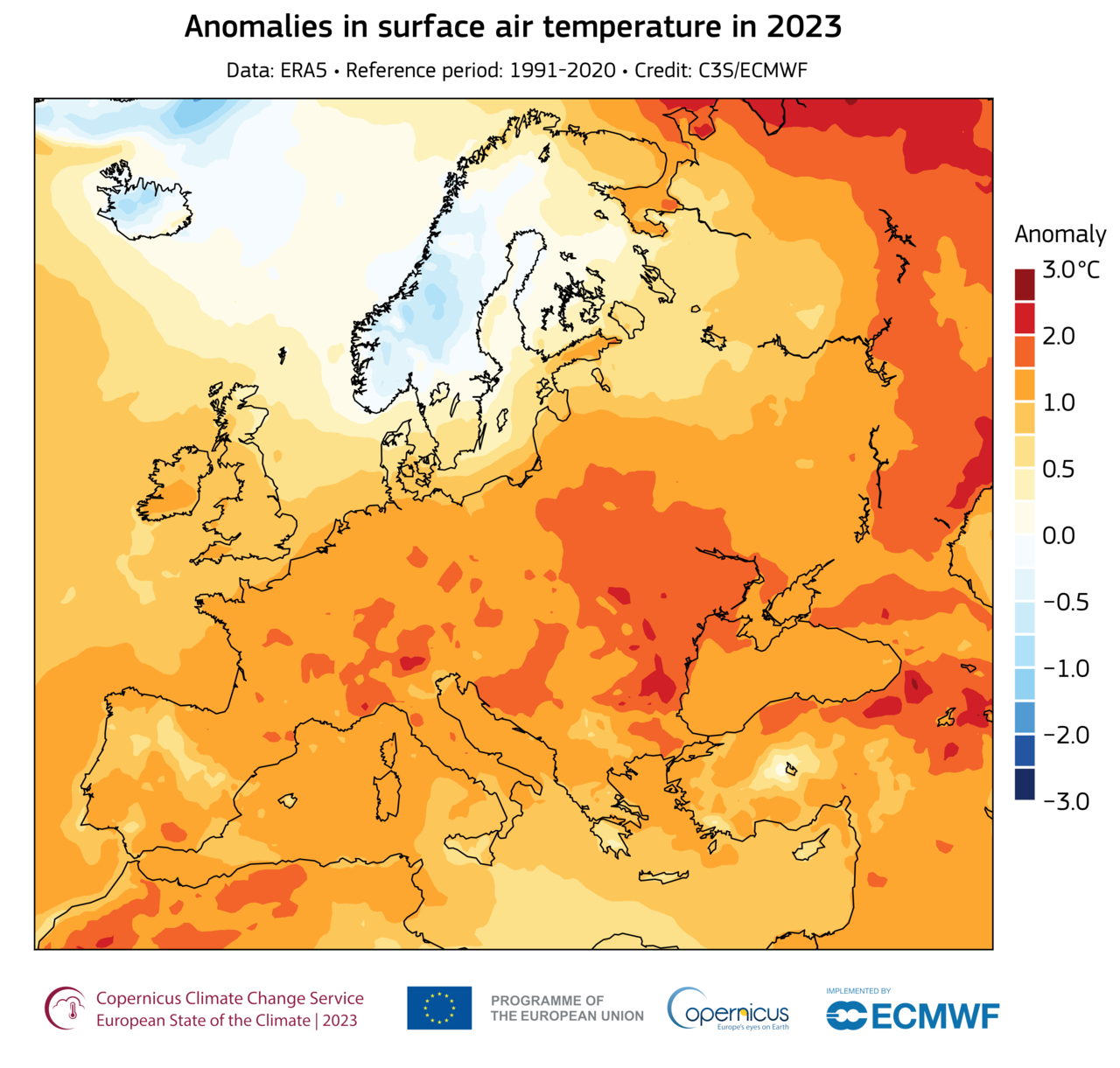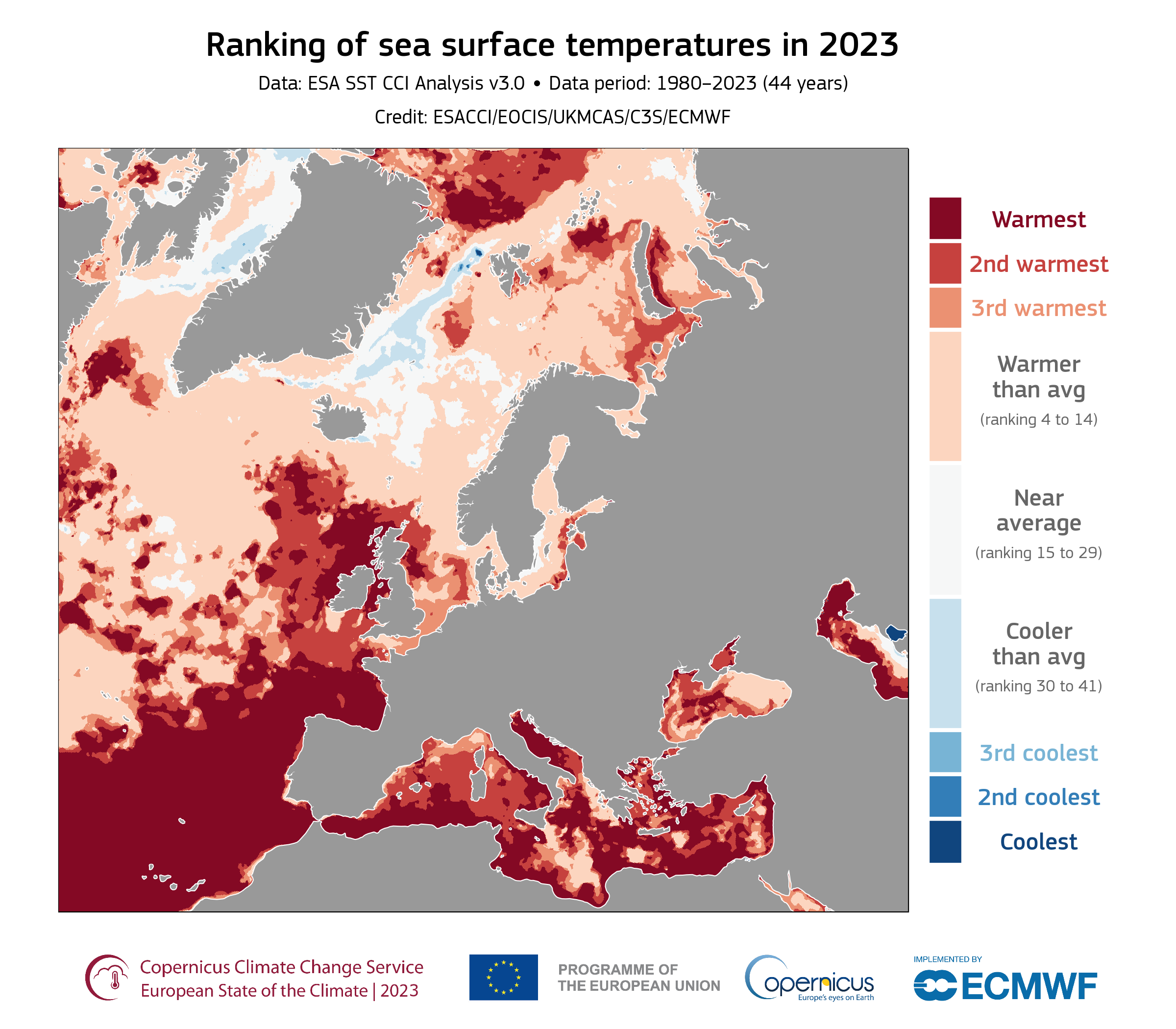Last year Europe experienced its joint warmest or second warmest year on record, depending on the dataset, while the average sea surface temperature across Europe was the warmest on record. The 2023 edition of the Copernicus Climate Change Service’s (C3S*) European State of the Climate (ESOTC) report, produced jointly with the World Meteorological Organization (WMO) for the first time, paints a sombre picture. Along with record temperatures came drier-than-average surface soil moisture, wildfires, droughts, and flooding. Here, we take a closer look at some of the main findings from ESOTC 2023. For a comprehensive review of the state of the climate in Europe, the Arctic, and globally in 2023, read the full report , or you can get a detailed snapshot in the ESOTC 2023 summary.
The 2023 ESOTC report, published on 22 April, provides descriptions and analysis of climate conditions and variations from across the Earth system. This year, in addition to examining key events and their impacts, it also discusses climate policy and action, with a focus on human health. The data in ESOTC 2023 sound a warning bell for urgent coordinated global action to mitigate climate change.
Temperatures for the year were above average across most of Europe, with some parts of eastern Europe seeing temperatures up to 2.6°C above average and parts of the Alps up to 2.3°C above average. Much of southeastern Europe, and parts of western and central Europe, saw their warmest year on record.
Europe is the fastest warming continent, with temperatures rising at around twice the global average rate. According to ESOTC 2023, the three warmest years on record for Europe have all occurred since 2020, and the ten warmest since 2007.
“In 2023, Europe witnessed the largest wildfire ever recorded, one of the wettest years, severe marine heatwaves and widespread devastating flooding. Temperatures continue to increase, making our data ever more vital in preparing for the impacts of climate change,” said C3S Director Carlo Buontempo.

The Arctic region also experienced higher-than-average temperatures - 2023 was the sixth warmest on record for the Arctic as a whole. For Arctic land, it was the fifth warmest, closely behind 2022. The five warmest years on record for Arctic land have all occurred since 2016. The European Arctic experienced warmer-than-average conditions throughout most of the year, with temperature anomalies reaching up to 10–11°C above average in January and February in some areas.
Globally, 2023 was the warmest year on record, at 0.60°C warmer than the 1991–2020 average and around 1.48°C warmer than the pre-industrial average (based on the C3S ERA5 reanalysis dataset). Close to 50% of days were more than 1.5°C warmer than the pre-industrial average and two days were, for the first time, more than 2°C warmer.
In 2023, the average sea surface temperature (SST) for the ocean across Europe was the warmest on record. Parts of the Mediterranean Sea and the northeastern Atlantic Ocean saw their warmest annual average SST on record. In June, the Atlantic Ocean west of Ireland and around the United Kingdom was impacted by a marine heatwave that was classified as ‘extreme’ and in some areas ‘beyond extreme’, with sea surface temperatures as much as 5°C above average.

Summer 2023 was not the warmest on record in Europe, but saw conditions that were, at times, extreme. There were contrasts in temperature and precipitation, across the continent and from one month to the next. The ‘extended summer’ (June to September) saw heatwaves, wildfires, droughts and flooding.
Northwestern Europe saw its warmest June on record, while Mediterranean areas saw well-above-average precipitation for the month. In July, this pattern was almost reversed. In August, southern Europe saw warmer-than-average temperatures, and September was the warmest on record for Europe as a whole. Much of Europe was impacted by heatwaves during the extended summer, and both August and September also saw severe flood events.
“The climate crisis is the biggest challenge of our generation. The cost of climate action may seem high, but the cost of inaction is much higher. As this report shows, we need to leverage science to provide solutions for the good of society,” WMO Secretary-General Celeste Saulo said.
Linked to the high temperatures, 2023 saw a record number of days with ‘extreme heat stress’. The report notes that there is an increasing trend in the number of days with at least ‘strong heat stress’ across Europe. At the peak of a heatwave in July, 41% of southern Europe was affected by at least ‘strong heat stress’, with potential for health impacts. Overall, the number of adverse health impacts related to extreme weather and climate events is rising - heat-related mortality has increased by around 30% in the past 20 years and heat-related deaths are estimated to have increased in 94% of the European regions monitored.

The 30 most severe heatwaves in Europe, 1950–2023. The size of a circle is proportional to the area affected by the corresponding heatwave. Heatwaves ranked as more severe are indicated by darker colours, and grey indicates those with a ranking of severity below 10. Source: DWD. Credit: DWD/C3S/ECMWF.
In July 2023, for the first time in history, the climate crisis and related extreme weather events were declared a public health emergency by the World Health Organization (WHO). Given the implications of climate change for public health, ESOTC 2023 contains a special feature on climate resilience in the health sector. In it, we read that proactive, timely and effective adaptation can reduce risks to human health and that the WMO and WHO are working together to address the human health risks posed by extreme events.
In addition to the challenges that heatwaves present to health, there are other extreme weather events that severely impacted people in Europe in 2023. According to preliminary estimates for the year from the International Disaster Database (EM-DAT), last year in Europe 63 lives were lost due to storms, 44 to floods and 44 to wildfires. Furthermore, economic losses related to weather and climate in 2023 are estimated to be at least €13.4 billion.
For most of 2023, Europe saw above-average fire danger. High levels of fire danger were seen at the start of summer in northern Europe, driven by warmer-than-average conditions observed in May and June. Later in the summer, while northern areas experienced wetter-than-average conditions, a persistent drought contributed to higher fire danger conditions in southwestern Europe. Large fires occurred in Portugal, Spain, Italy and especially Greece, which saw the largest wildfire ever recorded in Europe, at around 96,000 hectares.

As a result, the 2023 wildfire season saw the fourth largest burnt area on record in the European Union, at a total of around 500,000 hectares. Total monthly fire emissions were at or below average throughout the year, except for July, when the large fires in Greece led to above-average values.
During 2023, Europe was around 7% wetter than average, with most of Europe experiencing wetter-than-average conditions – in the ERA5 dataset it was the fourth wettest year and the wettest since 1981. As a result, during the year, one third of the European river network saw river flows exceeding the ‘high’ flood threshold, and 16% exceeding the 'severe' flood threshold.

Record or near-record high river flows were seen in major river basins, including the Loire, Rhine, and Danube, due to a series of storms between October and December. According to preliminary estimates from the International Disaster Database (EM-DAT), flooding in 2023 affected an estimated 1.6 million people in Europe and caused around 81% of the year’s economic losses due to weather and climate-related events on the continent.
However, 2023 also saw a below-average number of days with snow in Europe, particularly across central Europe and the Alps during winter and spring. This, along with high temperatures during summer, has contributed to a net loss of glacier ice in all parts of Europe. The most drastic example of this is the Alps, which has seen glaciers lose around 10% of their remaining volume over 2022 and 2023.
"Robust environmental information, underpinned by data from the European Union’s Copernicus Earth Observation Programme, is revealing significant changes across our planet. The data presented in the European State of the Climate are alarming, but this research is also a vital tool in our aims to transition towards sustainable energy, reduce net greenhouse gas emissions, and become the first climate-neutral continent by 2050,” said Mauro Facchini, Head of Unit for Earth Observation at the Directorate General for Defence Industry and Space (DG DEFIS), European Commission.
Every year, the ESOTC report analyses climate data from the previous year, placing it into the context of long-term trends. With its quality-assured data, expert analysis and broad perspective, ESOTC is a valuable resource for policymakers, allowing them take informed decisions about the actions needed to deal with the impacts of climate change. ESOTC 2023 is a milestone report, in that it is the first of the ESOTC reports jointly produced by C3S and the WMO. This collaboration enhances the breadth and depth of insights and expands the scope of data sources available for analysis.
*C3S is implemented by the European Centre for Medium-Range Weather Forecasts with funding from the European Commission.